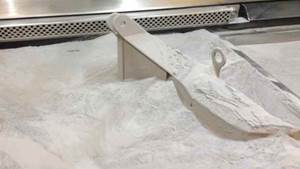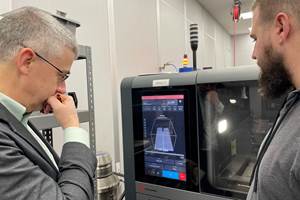Automated Postprocessing Achieves Surface Finish for Shrouded Impellers
Ingersoll Rand achieved 80 percent reduction in roughness average for its 3D-printed shrouded impellers using the automated Hybrid Deci Duo from PostProcess Technologies.
Impellers are a key component for the advanced air compressors produced by Ingersoll Rand. In the past the company has relied on open impeller designs that require clearance between the impeller and stationary inlet. The challenge is that compression gas recirculates in that clearance space, creating a slip loss that reduces efficiency and performance. Engineers at Ingersoll Rand recognized an efficiency opportunity by moving from open to a shrouded impeller design. Shrouded impellers eliminate slip losses, thereby improving the overall performance and efficiency of the total compressor package.
However, shrouded impellers are inherently difficult to manufacture. Because impellers must rotate at 60,000 rpm, the design has very tight tolerances to meet aerodynamic testing and the welding process required for the shrouded impellers restricts the aerodynamic design of the blades. Furthermore, the blades require excellent surface finishing to optimize aerodynamic performance. Issues with welding and surface finish often reveal themselves during quality control, creating significant rework. It can take months to successfully build a shrouded impeller using traditional manufacturing techniques.
3D Printing Shrouded Impellers
The Ingersoll engineering team was tasked with commercializing a shrouded impeller design using additive manufacturing (AM). AM offered a compelling solution encompassing complete design freedom and the ability to build a shrouded impeller as a monolithic part, eliminating the problematic welding. However, surface finish remained a challenge, as the impellers require a smooth finish to meet performance thresholds.
At Ingersoll, the shrouded impellers are made from titanium and nickel alloy and arrive off the 3D printer at an roughness average (Ra) value that does not meet the specifications from the engineering team. The problem is compounded within the impeller’s long internal channels that measure less than 0.5-inch (12.7 mm) wide and range from 5 to 7 inches (127 to 177.8 mm) long.
Surface finishing methods including manual sanding, grinding tools, chemical etching and combinations of these strategies could not meet the requirements for quality and consistency. “The final geometry of the flow path must remain as unaltered as possible after postprocessing of any kind,” says Ioannis Hatziprokopiou, mechanical engineer, new product development, Ingersoll Rand Compression Technologies & Services. Ingersoll needed a replicable way to achieve surface finish requirements on the complex geometry of the shrouded impeller. The company brought its dilemma to PostProcess Technologies, a provider of surface finish systems for additively manufactured parts.
Achieving a Consistent Surface Finish
To meet the surface finish requirements with the necessary consistency, PostProcess recommended the automated Hybrid Deci Duo. This postprocessing system uses the company’s Automat3D software to optimize a combination of energy and chemistry (including detergents and suspended solids) that can achieve the desired surface effect while preserving fine-feature details.
Using benchmark parts to establish operating settings that met Ingersoll’s standards, the PostProcess solution was able to consistently finish parts that passed aerodynamic testing. The Deco Duo produced an average of 70 to 80 percent reduction in Ra for parts run for 20 minutes or less. Benchmark testing has shown consistent, repeatable Ra results for the 3D-printed shrouded impellers using this process.
“Photochemical machining, extrude honing and micro polishing or micro machining all yield very good results when applied correctly; however, extensive tooling and equipment costs, setup times and required DOEs prior to applying the surface finishing method to obtain a repeatable process have made the Deci Duo a better option,” Hatziprokopiou says. “In addition, some of aforementioned finishing techniques unevenly remove material inside the flow path of the impeller, whereas the Deci Duo uniformly treats the entire surface of the flow path.” Additionally, he says that the system’s repeatability, minimal setup, fast processing times, ease of operation and low cost of ownership are also beneficial.
The 3D-printed shrouded impellers have been implemented on the last three stages of the six-stage 6R3MSGEP+4/30 engineered air booster machine from Ingersoll Rand. This single-process, multi-stage geared centrifugal compressor has a final discharge pressure of approximately 1,100 psig.
Related Content
Copper, New Metal Printing Processes, Upgrades Based on Software and More from Formnext 2023: AM Radio #46
Formnext 2023 showed that additive manufacturing may be maturing, but it is certainly not stagnant. In this episode, we dive into observations around technology enhancements, new processes and materials, robots, sustainability and more trends from the show.
Read MorePostprocessing Steps and Costs for Metal 3D Printing
When your metal part is done 3D printing, you just pull it out of the machine and start using it, right? Not exactly.
Read MoreFreeform: Binder Jetting Does Not Change the Basics of Manufacturing
Rather than adapting production methodologies to additive manufacturing, this Pennsylvania contract manufacturer adapts AM to production methodologies. In general, this starts with conversation.
Read MoreDMG MORI: Build Plate “Pucks” Cut Postprocessing Time by 80%
For spinal implants and other small 3D printed parts made through laser powder bed fusion, separate clampable units resting within the build plate provide for easy transfer to a CNC lathe.
Read MoreRead Next
Bike Manufacturer Uses Additive Manufacturing to Create Lighter, More Complex, Customized Parts
Titanium bike frame manufacturer Hanglun Technology mixes precision casting with 3D printing to create bikes that offer increased speed and reduced turbulence during long-distance rides, offering a smoother, faster and more efficient cycling experience.
Read MoreCrushable Lattices: The Lightweight Structures That Will Protect an Interplanetary Payload
NASA uses laser powder bed fusion plus chemical etching to create the lattice forms engineered to keep Mars rocks safe during a crash landing on Earth.
Read MorePostprocessing Steps and Costs for Metal 3D Printing
When your metal part is done 3D printing, you just pull it out of the machine and start using it, right? Not exactly.
Read More



















